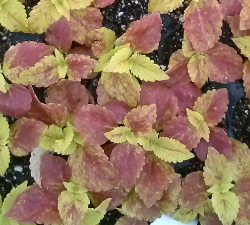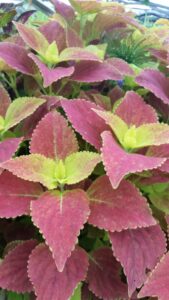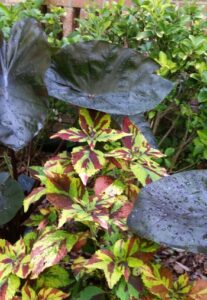S & J Nursery’s Coleus
Coleus Origins:
Coleus is a member of the mint family from Southeast Asia and can be considered a permanent addition to the Florida landscape in Zones 10-11. In our Northeast Florida gardens, coleus is most often planted as an annual and replanted each spring, although when left in ground they will often re sprout from the roots and grow a new beautiful coleus plant for the following season after winter. They also root easily from cuttings and can
be overwintered indoors in a bright window.
Coleus Foliage Heights and Textures:
Coleus heights, textures and colors vary widely from plant to plant. There are trailing, low growing , mid height and rather large coleus selections that can grow up to 3 ft in height! Colors on coleus foliage can range from pale yellow to dark red and everything in-between. There are smooth leaf coleus and heavily cut decorative leaf coleus, and it seems that there is a coleus plant for every taste and garden setting.
Coleus Plants Sun Exposure:
– Coleus plants will vary in appearance as a direct result of the amount of sun exposure they are getting. Each coleus selection will perform differently from another selection and all will range in appearance and height from the EXACT same plant placed in a full shade area or a full sun
area.
For example, you may choose an Alabama Sunset coleus selection that all of the information says will tolerate a full sun location, plant it in full
sun and have a very light yellow plant with just hints of a brick red coloring on each leaf. Or you may choose an Alabama sunset coleus and plant it in morning sun and afternoon shade and have a much brighter more vivid
leaf coloring with strong brick red tones to the leaves an a bright yellow green new growth. The same plant, planted into different sun exposures is almost unrecognizable. Below is Alabama sunset foliage in different light exposures.


– While some coleus can change dramatically in different exposures, some can tolerate different levels of sun and shade without loosing much in the way of color so feel free to try them in different locations to see what you get. I like to plant most of my coleus plant selections in partial or dappled shade through the day or a morning sun and afternoon shade location. I find that most varieties can dry out to quickly and loose color in afternoon sun areas here in Northeast Florida landscapes.
Coleus Plants Soil Preference / Salt tolerance:
– Coleus is not particular about the components of the soil as long as it remains fairly moist. They do not do well in dried soils and do best when planted in soils that have been generously amended with compost or composted manures.
-Low Salt tolerance.
Coleus Growth Rate:
– Regardless of the variety of coleus you choose, they are all very fast growing plants that will quickly fill in gaps in the landscape or containers.
Coleus Blooms:
-Coleus are not noted for their blooms but rather their large and brightly
colored decorative foliage. Most people opt to pinch out the white or lavender flower stalks as they emerge so as not to detract from the foliage.
Coleus Plant Water Requirements:
– Coleus will suffer if allowed to dry out. Plant them with a generous portion of good quality compost or composted manure.
– When planting in containers consider adding “Soil Moist” granules into the
soil before planting to help your container hold water for longer periods of time.
– Be sure to water daily for the first week after planting and two to three times per week as needed during the growing season.
Best Uses For coleus in the Northeast Florida | Jacksonville | St. Augustine area garden:
– Easy maintenance colorful plant for perennial beds and flower borders.
– Great selection for a mixed container planting.
– Plant in masses for a bold display that cant be missed!
– Coleus is a perfect companion plant for other perennials in the garden and adds both color and texture to the landscape.
– Deer resistant plant selection!
 Care of Coleus in the Northeast Florida | Jacksonville | St. Augustine area landscape:
Care of Coleus in the Northeast Florida | Jacksonville | St. Augustine area landscape:
– Water every day during the establishment period after planting in the garden from a nursery container, once plants have established themselves into the landscape, you can begin to taper watering back two or there times per week if local rainfall levels are low.
– Try leaving the roots to see if your coleus return next spring, just trim back the foliage to a few inches above ground level, cover with a 6 inch thick layer of pine straw and leave roots in place for next years growth once the plant is damaged after a frost.
– Trim back foliage and blooms in mid summer in hot humid climates for best results, the more you pinch back the foliage of a coleus plant the fuller it will become! Remember to give the plant a bit of fertilizer when trimming and your coleus plant will be back again and more beautiful than ever in no
time!
– Fertilize each spring, and again when trimming in late summer with a handful of garden compost or a mixture of Milorganite and a slow release poly coated plant food such as Osmocote or Stay Green general purpose plant food or 10-10-10.
Click here for more information on coleus selections available throughout the year.
Coleus Varieties for Northeast Florida Landscapes


